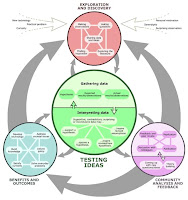 Step back for a minute and take a new look at our fundamentals as is said in rugby football circles.
Step back for a minute and take a new look at our fundamentals as is said in rugby football circles.No I am not asking the reader to embark on what can be seen as some unpleasant introspection of the human condition it's weakness or failure. On the contrary let's take a break from my/our current bandwagon of economic, climate and energy dilemmas if only to better our approaches to finding "sustainable solutions" to these very serious issues and to look at the positive and strong supportive role of science (in society).
"Science's Big Picture."
 A newly developed website has made understanding science, its processes, it's interactions and it's wide reach, a relatively simple, very attractive and enjoyable task. Although the site has been designed by teachers and lectures for teachers and includes elementary teaching resources, I firmly believe that the site will prove highly significant in clarifying the scientific method not as a linear process but as a system of interactions. It is, not only, a timely reminder and support for all professional in the science industry: a must for all scientists technologists, engineers including science communicators, be they scientists or laymen, but also to the general public, intrigued often worried by the influence of the scientific industry, its technology and engineering on their daily lives.
A newly developed website has made understanding science, its processes, it's interactions and it's wide reach, a relatively simple, very attractive and enjoyable task. Although the site has been designed by teachers and lectures for teachers and includes elementary teaching resources, I firmly believe that the site will prove highly significant in clarifying the scientific method not as a linear process but as a system of interactions. It is, not only, a timely reminder and support for all professional in the science industry: a must for all scientists technologists, engineers including science communicators, be they scientists or laymen, but also to the general public, intrigued often worried by the influence of the scientific industry, its technology and engineering on their daily lives.In fact we are all to some extent scientists, for science arises from observation: observation of our surroundings both the natural world and change as well as man's contribution, material products and systems.
Of course testing ideas remains central to the new presentation, but it's no longer a simple thumbs -up or thumbs-down on a hypothesis. Instead, the data need to be interpreted, and researchers are often forced to go back and either revise their hypothesis, or the assumptions on which the hypothesis is based. No matter what happens, the arrows in the diagram make it clear that the process must be viewed as a system with multiple rounds of testing and revision are needed to refine ideas.
More...
Sources
1. Ars Technica.com/
2. Understanding Science accessed on 20 March 2009. University of California Museum of Paleontology.